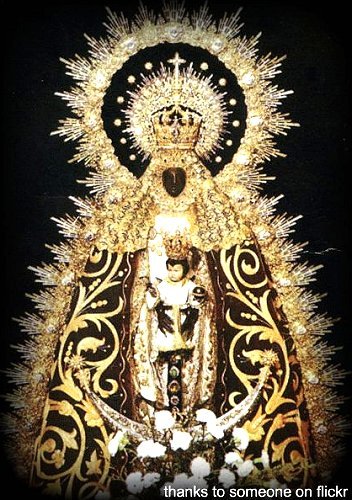Chipiona
Photo: Nikki Ballesteros
Our Lady of Regla
(Nuestra Señora de la Regla)
In her sanctuary facing the sea, an old fortress turned into a monastery, on the Paseo de Costa de la Luz on the corner of Avenida de Sevilla, region Cádiz in the state Andalucia, just S of the Doñana National Park, open 8-1, 4:30-8, probably 12/13th century, wood, 62 cm.
The bare historical facts available to us are that the monastery of Our Lady of Regla (the name of the bay where Chipiona lies) was founded in 1399. For this purpose the old fort was donated by the Duke of Arcos, Don Pedro Ponce de León, to the Agustinian monks who remained there until 1835. Since then the monastery has been occupied by Franciscans who are still the custodians of the sanctuary.
But where did Our Lady of Regla, after whom the monastery was named, come from? Why was she already considered miraculous in 1330? How did she come into the possession of the Augustinians? A beautiful legend happily answers these questions. It began to circulate among the monastery's chroniclers in the 17th century, though it may have been an older oral tradition. Here is what it says:
The mutilated statue without regalia. The Madonna used to offer her son a pear. Only the white feet and red skirt are left of him.
One fine day an angel appeared to St. Augustin (354-430 A.D.) and commanded him to sculpt this image.¹ Augustine was an Algerian Berber from the city Hippo Regius. (While this made him African it did not make him black but "olive" skinned.) When the Germanic Vandals laid siege to his city he prayed his heart out, but neither he nor his Black Madonna could save his people. Three months into the siege St. Augustine died, aged 75, and 11 months later the city fell. Augustine's famous disciple Saint Cyprian and other African hermits managed to escape death and took their teacher's Madonna to Chipiona, Spain. On the journey by sea they experienced a ferocious storm. This time the Dark Mother did protect her children and so she became, not the patron of Hippo, but of Spanish sailors. It served her well. Spanish sailors spread her fame to far off places. To this day she is venerated in Mexico, the Dominican Republic, the Philippines, Belgium, and in Regla, Cuba, a place outside of La Havana.
She enjoyed a peaceful veneration in her Augustinian hermitage in Chipiona for three centuries; then it was time to flee again. This time the invaders were Muslim Saracens and she went underground, literally.
The mutilated statue without regalia. The Madonna used to offer her son a pear. Only the white feet and red skirt are left of him.
The monks hid her in an underground cistern next to a fig tree where she remained five hundred years. When it was time to come out, Our Lady appeared to a priest and showed him a vision of the place where she was buried. She asked him to come, unearth her, and return her to her old sanctuary. The obedient priest immediately went on his quest for the buried treasure. One day he was resting under a fig tree when he suddenly heard an angelic voice coming from deep in the earth, saying: "This is my place!" When the priest began to dig he opened the cistern or underground cave and found not only the statue of the Black Madonna but also a burning oil lamp and a chalice. To this day a little chapel near the great sanctuary marks the place where Our Lady of Regla was found. It is called Humilladero (the one who humbles), and the cistern and fig tree are also still there.²
After this amazing discovery her old hermitage quickly became too small to hold all the pilgrims who flocked to see her. The place was enlarged and then replaced by bigger structures until it received today's form.
The monks collected documented reports of miracles. Between 1340 and 1636 they gave their official recognition to 104 miracles. The Black Madonna, they say, freed prisoners, saved sailors from shipwrecks and children from drowning in wells, healed the sick, etc.³
The feast day of Our Lady of Regla is September 8th, traditionally said to be the birthday of the Virgin-Mother of Christ. Festivities begin with a vigil the night before. On the big day itself up to eighty thousand people participate in a nine kilometers long procession. The Madonna appears in her most regal wardrobe, but there are also puppets, dancers, singers, lots of wine, and fireworks at night.
That the Augustinians have a special devotion to the Black Madonna is evidenced not only here in Spain but also in San Severo, Italy and other places. For example the famous Black Madonna in Brno, Czech Republic, also hangs in an Augustinian monastery. Was it only because their founder, St. Augustine, was North African and had presumably venerated a Black Madonna, or is there more to it? I wouldn't put it past the monks of this order to appreciate the deeper meaning of the Dark Mother with the white child. Yet so far I have no proof that they would agree with my interpretation, which I elucidate on the Black Madonna of Foggia page.
Footnotes:
1. Wikipedia article on Virgen de la Regla
2. https://www.corazones.org/maria/regla_virgen.htm
3. Onze-Lieve-Vrouw van Regula, de Zwarte Madonna, Memlingmuseum-Sint-Janshospital, Brugge 2004, p. 9




